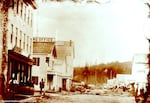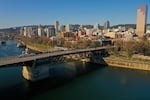Oregon’s largest city was incorporated on this day 171 years ago – but the place we know as Portland now almost had a different name.
In 1845, business partners Asa Lovejoy and Francis Pettygove determined the name of a new and growing town on the Willamette River through the flip of a penny. Lovejoy was from Boston, Massachusetts. Pettygrove was from Portland, Maine. Pettygrove won the toss — and the naming rights.
Six years later, on Feb. 8, 1851, the city was officially incorporated under the name it had become known by.
The “Portland Penny” is on display at the Oregon Historical Society.
Before the Oregon Trail settlers
Long before that fateful coin toss, and before there was a anniversary of incorporation to celebrate, the land now designated “Portland” was first home to the Multnomah, Kathlamet, Clackamas, bands of Chinook, Tualatin Kalapuya and Molalla tribes who established communities and seasonal traditions along the Willamette and Columbia rivers. Today, Portland has the nation’s ninth largest urban Native American population.
White settlers began the venture west along the Oregon Trail in the 1840s. Thousands of new arrivals quickly poured into the territory.
In 1850, Congress passed the Oregon Donation Land Act. The federal law stripped tribes of their land, giving it to whites who stepped foot in the region less than a generation earlier. Settlers claimed 2.5 million acres of tribal land, including the sites that formally became Portland a year later.

Portland in 1851, the year the city was incorporated. This street was called Front Avenue. The ship in the background was at a docking area. Front Avenue eventually became Naito Parkway.
City of Portland Archives and Records Center / Courtesy
A very white city
Just over 77% of Portland residents are white, according to the 2020 U.S. Census. It is the whitest large city in the nation.
The history of Oregon made it so.
As settlers arrived in the Oregon territory and displaced Native Americans, what some have called a “white utopia” took shape. Oregon was founded with laws designed to exclude people of color. In 1844, the government of the territory simultaneously banned slavery and required all African Americans to leave. Five years later, the exclusion of African Americans became absolute, under laws that stayed in place until they were overturned by post-Civil War amendments to the U.S. Constitution.
As settlers came from the West to Portland, so did Asian immigrants from the East. A steady flow of Cantonese-Chinese people came to Oregon from 1860 to 1885. From 1880 to 1910 Portland’s Chinatown was the second largest in the country, only behind San Francisco. During the 1890s, an influx of people from Japan arrived in Portland for labor opportunities. Immigrants opened businesses and created neighborhoods in the city.
The arrival of people from Asia brought on new racial restrictions. From the early 1880s through 1942, during what was known as the Exclusion Period, U.S. laws prohibited new immigration from China, banned interracial marriage, and kept Chinese people from participating in many aspects of civic life.
By the end of the 19th century, Portland was true to its name as a very active port city, as well as becoming a railroad hub. With ships and trains, commerce traveled through Portland and the city grew to accommodate. Portland began to look more diverse. People of color populated the city to seek industrial jobs, to reside and to start families.
In the 20th century, racial restrictions continued to shape where people lived – and whether they could live in Portland at all. Two examples include the 1942 detention of thousands of Japanese Americans at what is now the Portland Expo Center, and decades of redlining that restricted where Black people could buy homes.
Today, Portland’s BIPOC population is relatively small.
A city of stumps in a state built with trees
As Oregon’s population grew, so did the need for infrastructure. During the latter half of the 1800s, trees were cut down in droves to build homes and other structures, and Portland earned the nickname Stumptown.
By 1938, Oregon led the nation in wood production. Oregon still produces the most wood building materials of any state.
Oregon’s timber industry can be called an economic backbone of the state. It inspired Timber Jim, the first lumberjack mascot of Portland’s professional soccer team.
OPB’s Timber Wars podcast dives deep into this part of Oregon’s identity.

Aerial view of the Burnside Bridge and downtown Portland, Oregon, March 20, 2020.
Stephani Gordon/OPB
‘Keep Portland Weird’
When Portland comes up in media – news or entertainment – the city is typically followed by a progressive or campy description.
“Keep Portland Weird” has become an unofficial slogan. Funnily enough, the phrase was borrowed from “Keep Austin Weird.” The Portland that got its name from an East Coast city in Maine had yet again drawn inspiration from a faraway city.
Popular culture portrays Portland as a quirky, artsy city, a reputation businesses and travel agencies have leveraged to tourists.
And visitors see that Portland is indeed pretty weird. City residents can point to creatives who have called Portland home, from authors Chuck Palahniuk, Ursula Le Guin and Beverly Cleary, to Darcelle, the world’s oldest drag queen, to James Beard, who launched Portland onto foodies’ radar.
Portland puts on quite the show. The city’s music scene is growing in recognition – with talents such as Esperanza Spalding, Pink Martini and The Decemberists. There are festivals and markets galore, including many celebrations of local craft beer. In summer, people ride bikes without any clothes. In winter, the city’s prominent downtown White Stag sign lights up with a red nose.
And true to its history, Portland also faces deep-rooted civil issues.
Protests against racial injustice and police brutality projected Portland into the national stage in 2020. And many of the challenges other large cities are grappling with this decade are also unfolding here. Homelessness and addiction are ongoing struggles in the city. Gun violence continues to surge; there was a record number of homicides in the city in 2021.
In the 171 years since its incorporation, Portland has become a modern city with historical truths embedded in its core.




